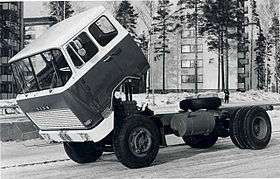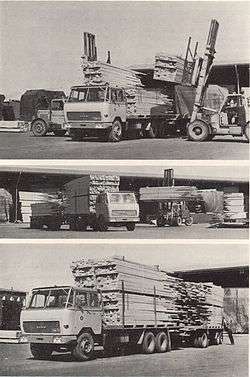Sisu KB-112
Sisu KB-112 is a three-axle lorry made by the Finnish heavy vehicle manufacturer Suomen Autoteollisuus (SAT) in 1962–1969. The vehicle was equipped with a technically advanced tiltable cabin. Its two-axle variant is KB-117 which was produced 1964–1969. Both versions were only produced small numbers.[1]
| Sisu KB-112 and KB-117 | |
|---|---|
 Sisu KB-117. | |
| Overview | |
| Manufacturer | Oy Suomen Autoteollisuus Ab[1] |
| Also called | Jyry-Sisu[2] |
| Production | KB-112: 1962–1969 KB-117: 1964–1969 |
| Assembly | Karis, Finland |
| Body and chassis | |
| Body style | forward control[1] |
| Layout | KB-112: 6×2 KB-117: 4×2[3] |
| Powertrain | |
| Engine | Leyland 0.680 11.1-litre L6 |
| Transmission | ZF, 6-speed, non-synchronised[1] |
| Dimensions | |
| Wheelbase | KB-112: 4 500 mm + 1 200 mm[4] |
| Length | KB-112: 9 250 mm[2][4] |
| Width | 2 500 mm[4] |
| Kerb weight | KB-112: 7 300 kg[4] |
| Chronology | |
| Successor | Sisu M-series |
KB-112 and KB-117 were followed by Sisu M-series.[1]
Planning
International road transportation grew heavily in 1960's. The shortest way from Finland to Central and Western Europe was over the Baltic Sea but as sea transportation of vehicles was not developed enough yet, the Finnish lorries often drove to Central Europe through Scandinavia, driving around the sea through Haparanda. The conventional long-nosed vehicles available at the time were not sufficient for a such long time travelling. The only way to sleep in cabin was on the floor, next to gear lever.[1]
Short-nosed vehicles were common in UK due to local restrictions of vehicle length. These vehicles were also noted by the Finnish Sisu drivers. SAT got demands from their customers for a COE vehicle which would help to maximise the load area. Also proper space for a driver's bed was on the wish list.[1]
Creating of a short-nosed vehicle was not a such big step to SAT as the company had previously designed for the state KB-102/KB-107 models with a fixed cabin over engine. As a small manufacturer, SAT listened carefully the signals from its customers. The company set a new project with an urgent status for a modern, state-of-art COE model. The main issue was to ensure an easy access to the engine, enabling maintenance and repairs. The work was started from a blank paper. Finally the cabin got a simple design but it was furnished with a proper bed placed behind the seats. The service problem was solved by a tiltable cabin.[1] Cabin ergonomy, primarily the driving position and instrument panel layout, was developed based on interviews of more than one hundred lorry drivers.[2]
KB-112 was the very first European serial produced lorry with a hydraulically tiltable cabin.[5][6]

Production
The first KB-112 lorries were produced and tested in 1962[1] and handed over to W. Rosenlew & Co. Oy in January 1963[1][2] in a special ceremony, in which also representatives of the press were present. SAT advertised that it had developed a COE vehicle in which all the positive sides of the arrangement were kept whereas the negative sides were eliminated. The Rosenlew representative, Mr. A. Vaarne told that compared to a conventional cabin with a bed inside the new cabin type enabled a 3 m² larger load area within the limits of the contemporary legislation.[2] The vehicles transported timber from Seikku sawmill to Mäntyluoto harbour in Pori.[1]
The two-axle KB-117, already with a stronger engine, entered market in 1964. SAT did not mention KB models on their list in 1969 any more; however, it is possible that some vehicles were made by a special request. The new M-series took the place of KB-112 and KB-117 in 1970. There are no exact records about the total quantity produced but it is estimated to be between 50 and 70 units which means that it was rare already originally.[1]
Technical data
Engine
The original engine was a six-cylinder inline diesel Leyland 0.680 with a displacement of 11.1 litres and an output of 165 horsepower (SAE). The models with this engine could be recognised from model name extension SP. The two-axle version came to market with a stronger engine as KB-117 BP; BP means the stronger PowerPlus version of the same engine type with a 210-horsepower output. Later a turbocharged variation of the latter model was added in the selection; the engine code was then BPT.[1]
Transmission
The clutch is pneumatically operated.[6] The gearbox is a non-synchronised six-speed ZF. In addition, the driven rear axle is equipped with an integrated two-speed reduction gear system.[1] The tyre size is 11.00-20".[4] At least one KB-112 logging vehicle, made for A. Ahlström, was equipped with Sisu Nemo hydraulic transmission system for trailers.[7]
Cabin
The over engine mounted entire steel made cabin[2] is hinged from its front end and can be tilted forward in 20 seconds by a hydraulic system operated by a hand pump. There are seats for driver and one passenger. The steering wheel can be adjusted in range of 7 cm forward and backward. The 220 cm wide cabin is equipped with a full length and 50 cm wide bed placed behind the seats[1] and fastened to the chassis from three points. The instrumentation includes an electrically operated speedometer and a revolution counter.[2]
Characteristics
The total weight of KB-112 is 17.5 tonnes[3] and with a fully loaded trailer 30 tonnes. The turning radius of 8.4 metres is, according to SAT, two metres smaller compared to an equivalent vehicle with a conventional cabin.[2]
The total weight of KB-117 is 12.5 tonnes.[3]
Remaining specimens
One KB-117 BP is fully restored. As of 2010 it is the only known specimen of its kind in the Finnish vehicle register.[1]
Sources
- Mäkipirtti, Markku. Sisu. Ajoneuvot Suomessa (in Finnish). 4 (2. ed.). Tampere: Apali Oy. ISBN 978-952-5877-05-2.
References
- Kekko, Iikka (2010). "Matkamalli – Sisu KB-117 BP '64" (PDF). Vanhat Koneet. Viipalemediat Oy (4/2010): 16–22. Retrieved 17 November 2012.
- "Jyry-Sisu KB-112 – Kippiohjaamo-bulldog". Sisu-Uutiset. Oy Suomen Autoteollisuus Ab (1.-2./1963). 1963. Retrieved 2012-12-08.
- "Sisu tuotteiden syntymävuodet". Sisuviesti. Oy Suomen Autoteollisuus Ab (2./1981): 23. 1981. Retrieved 2012-12-08.
- Mäkipirtti: Ensimmäinen Jyry-luokan bulldog. p. 95.
- "Veteraanikuorma-autoseura ry – Sisu Auton historia". Veteraanikuorma-autoseura ry. Retrieved 2013-07-07.
- Mäkipirtti: Sisu KB-112/117. p. 97.
- Mäkipirtti: Sisu nestemoottori (Nemo). p. 178–181.